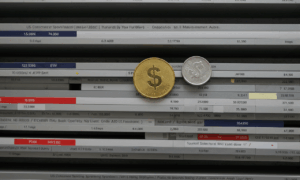ECONOMY: A Tale of Two Central Banks
This week, the economic spotlight shone brightly on consumers and central banks, revealing a complex picture of the global economy. Key reports and decisions are giving us clues about the direction of inflation and future borrowing costs.
- US Consumer Shows Signs of Fatigue: A key report on retail sales in the United States came in weaker than analysts expected. Think of retail sales as a national report card for consumer spending on goods, from cars to groceries. This slowdown suggests that households may finally be feeling the pressure from higher interest rates and persistent inflation, causing them to pull back on purchases. This is crucial news because robust consumer spending is the main engine of the U.S. economy. The Federal Reserve, the central bank of the US, will be watching this data closely as it decides when, or if, to lower interest rates this year.
- Bank of England Holds Rates, But Hints at a Cut: Across the Atlantic, the Bank of England (BoE) decided to keep its main interest rate unchanged at a 16-year high of 5.25%. However, the story is in the details. The meeting minutes revealed that for some policymakers, the decision was “finely balanced,” and they signaled that an interest rate cut could be on the table as soon as August. This indicates a growing confidence that the UK’s battle with inflation is nearing its end. This divergence in tone from the more cautious US Federal Reserve highlights how different major economies are charting their own paths out of the recent inflationary period.

FINANCE: Tech Dominance and Consumer Protection
The world of finance was dominated by a historic shift in corporate power and a regulatory push to bring more oversight to a popular new form of payment.
- Nvidia’s Coronation as King of the Market: In a landmark moment, chipmaker Nvidia briefly became the most valuable public company in the world, eclipsing tech giants like Microsoft and Apple. Its value is measured by market capitalization—the total worth of all its shares combined. This meteoric rise is fueled by the explosive demand for its specialized AI chips, which are the essential hardware powering the Artificial Intelligence revolution. This event underscores the immense financial power being generated by the AI boom and how it is reshaping the top tier of the corporate world.
- “Buy Now, Pay Later” Faces Stricter Rules: Regulators are moving to increase oversight of Buy Now, Pay Later (BNPL) services. These popular financing options, offered by companies like Klarna and Affirm, allow shoppers to split payments for purchases into smaller, interest-free installments. The proposed changes would treat BNPL lenders more like credit card companies, requiring them to provide stronger consumer protection. This includes investigating customer disputes and providing clear, standardized disclosures about costs and terms, bringing more traditional financial safeguards to this rapidly growing corner of fintech.
INVESTMENTS: Record Highs and Concentrated Gains
For investors, the story of the week was a market continuing its ascent to new heights, largely on the back of the same technological trends shaking up the financial world.
- S&P 500 Reaches New Peaks: The S&P 500, a broad index that tracks 500 of the largest U.S. companies and is often used as a benchmark for the entire stock market, continued to set all-time high records. While this is positive news, a key theme for investors is the growing market concentration. This means that a very small number of massive tech stocks—like the aforementioned Nvidia—are responsible for a large portion of the index’s gains. This raises important questions about diversification and the potential risks if these few high-flying stocks were to falter.
- The Semiconductor Sector Shines: The success is not limited to just one company. Investors are seeing strong performance across the entire semiconductor industry. These companies design and manufacture the essential microchips, or “brains,” that are critical for everything from smartphones and cars to the data centers driving the AI revolution. The broad rally in this sector shows that investors are betting on the long-term growth of AI as a major investment theme, looking for opportunities across the entire technology supply chain, not just in one or two household names.
Frequently Asked Questions (FAQ)
Why is weak retail sales data considered important news for the economy?
Consumer spending makes up roughly two-thirds of all economic activity in the U.S. When retail sales data is weak, it’s an early indicator that people are cutting back. This can signal a broader economic slowdown or even a recession. Central banks watch this data very carefully because a cooling economy can lead to lower inflation, which might give them the confidence to cut interest rates to make borrowing cheaper and stimulate growth.
What does ‘market concentration’ mean for an average investor?
Market concentration means that the performance of a major stock index, like the S&P 500, is heavily influenced by just a handful of very large companies. For an average investor, especially one who invests in index funds, this creates a hidden risk. While you may think you are diversified across 500 companies, your portfolio’s returns are disproportionately tied to the success or failure of a few giants. If those top companies run into trouble, they can pull the entire index down with them, impacting your investment more than you might expect. It highlights the timeless importance of ensuring your personal portfolio is truly diversified.



